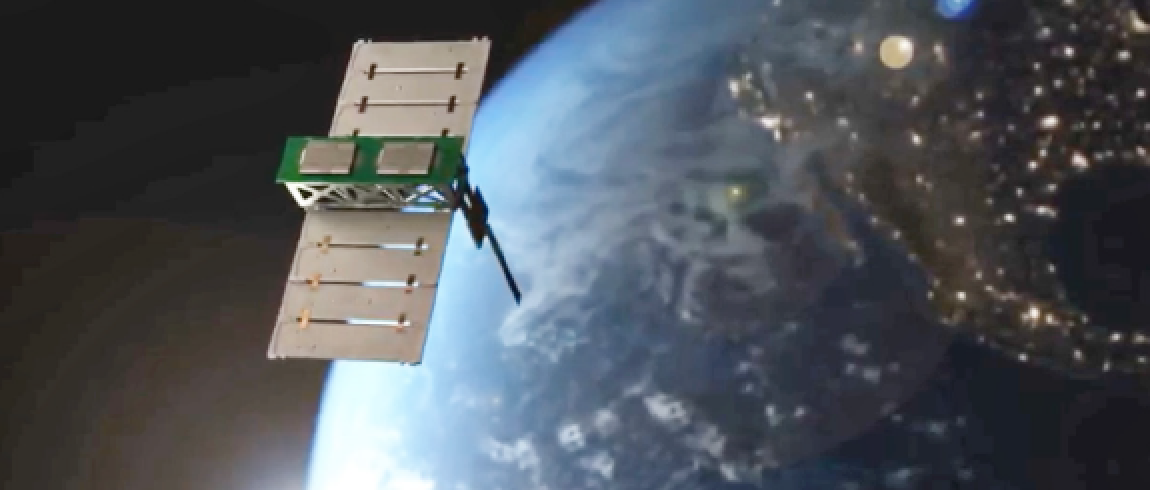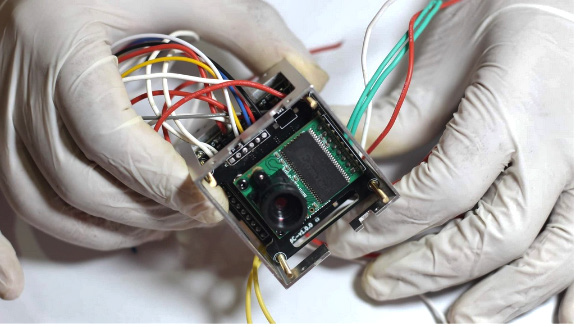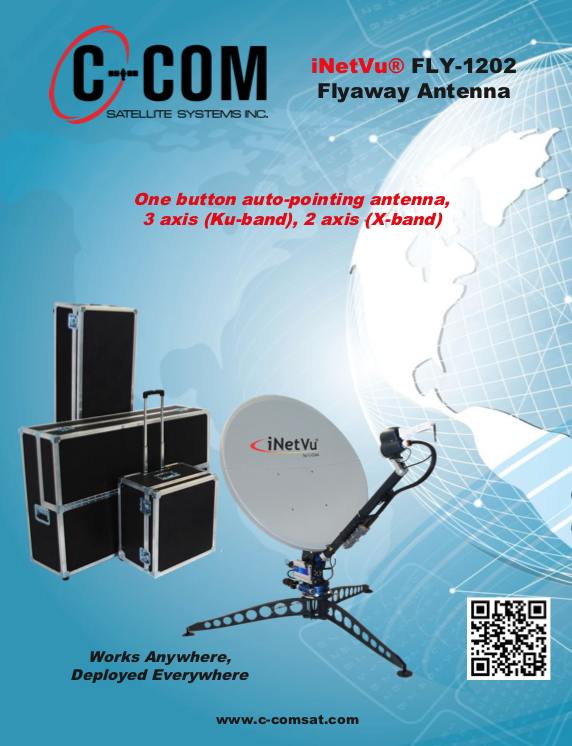Alba Orbital PocketQubes are smallsats that measure just 5 centimeters on each side and offer an affordable and accessible way for smaller organizations, universities, and individuals to conduct their own space missions without a NASA sized Budget.

Artistic rendition of Alba Orbital’s Unicorn smallsat on-orbit, courtesy of the company
With their compact size and low cost, PocketQubes are well suited for a variety of missions. Here are a few examples of the types of missions that can be flow using PocketQubes — these examples draw inspiration from missions that have flown in the past, as well as some new and upcoming missions.
Education + STEM Outreach
PocketQubes can be used to engage students and the general public in the exciting world of space exploration with hands on learning. For example, schools and universities could use PocketQubes to conduct on-orbit experiments or to teach students about space engineering, electronics, programming, scientific investigation and team collaboration.
Alba Orbital has launched a number of educational projects on behalf of academic institutions including TU Delft, Stanford University and Carnegie Mellon University. As PocketQubes are smaller, less expensive and faster to develop than traditional satellites and this makes space more accessible for universities, non-profit organizations and even middle and high schools.
Education case study: International Computing High School of Bucharest
ROM-Space is a group of high school students (aged 15 to 18) from the International Computing High School of Bucharest and they launched Romania’s first PocketQube, which also happened to be the country’s second satellite.
ROM-2 (Romanian Orbital Mission 2 — photo top left, second column) is a 1p satellite that will be a member on the next SpaceX mission in 2023. The satellite carries an
Earth Observation (EO) payload to deliver satellite imagery of the Earth through amateur radio frequencies.
As some of the youngest ever satellite builders, ROM-Space set out to prove that even high school students can design, build and launch their own spacecraft to orbit. They hope to inspire students to pursue careers in STEM fields by giving them a concrete example of the exciting and cutting-edge work that is possible in these fields. The impressive young team are already planning their next missions for a future constellation of spacecraft.
Educational PocketQube missions tend to be the first step toward bigger space ambitions, as many of the students tend to form their own start-ups (as seen with Hello Space and Innova Space) after hosting their first missions, or they continue to develop more complex satellite missions for deeper research, such as the Budapest University of Technology and Economics’ ‘SMOG constellation’ project.
PocketQubes offer a valuable tool for education and STEM outreach, providing students with hands-on learning opportunities, inspiration as well as access to real-world scientific data. By engaging students in these exciting and cutting-edge projects, PocketQubes have the potential to help cultivate a new generation of STEM professionals and encourage the next generation of space explorers.
Earth Observation

PocketQubes can be equipped with cameras and other sensors to capture images of the Earth’s surface. This data can be used for a variety of applications, such as monitoring natural disasters, tracking deforestation or monitoring agricultural assets.
As PocketQubes can be built and launched at much lower cost when compared to traditional satellites, this allows smaller organizations to focus on niche’s in the EO data market that are currently underserved by the larger players in the industry. A notable example of this is Alba Orbital’s Night Lights smallsat constellation:
Earth Observation Case Study I: Alba Orbital’s ‘Night Lights’ Unicorns
Night time satellite imagery (or ‘Night Lights Data’) can be used to study light emissions from the Earth during the dark of night. Remote sensing of nighttime light emissions offers a unique dataset for researchers who are investigating disaster impacts and recovery, biological impacts of light pollution, and insights into national socio-economics ( just to name a few use cases).
However, the only way to currently access night lights data is to use either outdated weather satellites with resolutions as low as 750/m, or to ask an astronaut on the ISS to snap a pic while in orbit (pricey and quite inaccessible).
With their night lights constellation of 3p PocketQubes ‘Unicorns’, Alba Orbital will provide reliable night time satellite imagery of around 20/m with significantly higher revisit rates than other options on the market.
Alba Orbital raised a $3.4 million seed round via Y Combinator to expand on their imaging constellation, with additional investors from Skype and FitBit backing the vision of PocketQubes for EO.
Earth Observation Case Study II: ACME MyRadar’s Weather PocketQubes
In May of 2022, Alba Orbital successfully launched Myradar-1, TRSI-2 and TRSI-3 on board Rocket Lab’s historic ‘There and Back Again’ mission on behalf of rideshare client ACME AtronOmatic. Less than a month after the launch, the team behind the popular weather app — MyRadar — announced the successful downlink of imagery from orbit.
These pico-satellites served as an excellent, on-orbit technology demonstration for ACME’s upcoming ‘HORIS’ (Hyperspectral Orbital Remote Imaging Spectrometer) constellation of as many as 250 satellites.
The constellation intends to capture environmental data that will be paired with artificial intelligence and machine learning (AI / ML) to provide data fusion products for ACME’s government, federal and commercial customers. Some use cases of the HORIS dataset include monitoring extreme weather, illegal fishing, wildfires and national security.
Technology Demo
PocketQubes lend themselves as excellent platforms for on-orbit technology demonstrations. As they are much smaller, less expensive, and faster to develop than traditional satellites, they inherently present a much lower risk profile to demonstrate novel concepts.
For instance, launching a 1U CubeSat to demonstrate a new concept on-orbit — this would typically cost around 100,000 euros in launch costs alone and that means a lot of capital and work is invested in taking a bet on your technology working on-orbit on the first go (and that can be a difficult task). Whereas, with a 1p PocketQube, launch costs are quartered. This means you can experiment on a much less costly scale, or decide to launch multiple missions and improve in-space prototypes using rapid, iterative design cycles, all with the lessons learned from orbit.
Technology Demonstration Case Study I: ATL-1
An example of this type of mission is ATL-1, a 2p PocketQube flown by Rocket Lab and Alba Orbital in December of 2019. Developed by ATL Ltd., and the Budapest University of Technology & Economics (BME), ATL-1’s primary mission objectives were to conduct thermal insulation experiments to test on ATL’s new thermal materials in space, while collecting DVB-T Band spectrum data as part of aforementioned BME’s ‘Electrosmog’ research project.
The demonstration of technology can be that of PocketQube-sized subsystems or components themselves, but such can also be performed for technology that is meant for larger platforms. These technology demonstrations can help advance the state-of-the-art space tech and enable new capabilities for future space missions, such as advanced communications systems, propulsion systems or control algorithms.
Internet of Things (IoT) Constellations
PocketQube constellations dedicated to providing global IoT services appear to be one of the most popular use cases of PocketQubes so far, as these small spacecraft offer relatively low cost when compared to larger satellites. This cost-effective scalability makes them ideal for IoT constellations that require a large number of satellites to cover remote regions that are left without communication coverage or mobile networks.
IoT constellations can be applied to a range of industry solutions, from Agricultural and Environmental monitoring, to Maritime surveillance, asset tracking and Disaster response.
There are already a number of companies leveraging PocketQube constellations to provide IoT services from orbit. Two start-ups engaged in Alba Orbital recent launch campaigns are Hello Space from Turkey and Hydra Space Systems from Spain.
RF Spectrum Monitoring / RF Sensing missions
There’s a range of applications you could carry out with an RF sensing/monitoring PocketQube mission. The original concept for the 2p Unicorn-1 satellite was to take an ADS-B payload (commercially available from SkyFox Labs) and include a high gain, stubbed, helix antenna for the purpose of tracking aircraft.
PocketQubes could also be launched with AIS payloads for the purpose of tracking maritime vessels. AIS is slightly trickier than ADS-B as the required wavelength is much longer at 162 Mhz (vs. 1090Mhz for ADSB); however, not impossible with a larger antenna.
RF Spectrum Monitoring Case Study: BME University’s SMOG satellites
When BME’s SMOG project development started in 2013, other groups launched an initial wave of PocketQube satellites. However, these were the first PocketQubes dedicated to monitoring electromagnetic pollution from Earth. Known as ‘Electrosmog,’ this cacophony can interfere with communications across devices, prompting large companies to develop more and more powerful technologies that, in turn, consume greater amounts of energy.
On December 6, 2019, SMOG-P and ATL-1 hitched a ride into space and entered Low Earth Orbit (LEO) with Alba Orbital on board Rocket Lab’s Electron launch vehicle. During its mission, the pocket-sized satellite scanned Earth’s entire surface twice daily, collecting and transmitting enough spectrum monitor subsystem data for researchers to produce a global electrosmog map within weeks.
In addition to the DVB-T (Digital Video Broadcasting-Television) spectrum monitoring payload, SMOG-P also featured a minuscule, onboard, radiation dosimeter that measured how much radiation hit the electronics during orbit and this data allowed the team to check for excess exposure.
The SMOG project subsequently developed a similar PocketQube satellite, SMOG-1, which was launched on March 22, 2021, and now being prepared is the 4th PocketQube for launch, MRC-100. Named in honor of the university’s radio club (Műegyetemi Rádió Club) 100th anniversary in 2024, the MRC-100 satellite is expected to launch with Alba Orbital and SpaceX in 2023 and is a continuation of the university’s SMOG project.
Amateur Radio
Another popular PocketQube mission is an Amateur Radio mission. PocketQubes can be used by amateur radio operators to provide a new platform for communication and experimentation. These missions are often flown to help expand the community of amateur radio enthusiasts and increase public engagement in the practice. Building and launching a PocketQube satellite provides amateur radio enthusiasts with an opportunity to learn about space technology, electronics and other related fields, which can be an exciting and educational experience.

PocketQubes are typically low cost platforms equipped with UHF/VHF amateur radio transceivers that makes it easier for amateur radio enthusiasts to communicate with the satellite and receive telemetry data.
Amateur Radio Case Study: $50Sat
$50Sat, also known as EAGLE-2, is an open-source, PocketQube satellite project that was designed to demonstrate the feasibility of building and launching a functional satellite for just $50. The project was launched in 2013 with the goal of providing a simple and low- cost platform for educational and amateur space missions.
$50Sat is equipped with a basic communications system, including a UHF/VHF transceiver, a microcontroller and a simple power system. The satellite is based on a modular design, which makes it easy to modify and customize for different missions.
One of the key innovations of $50Sat is the use of Commercial-Off-The Shelf (COTS) components, such as a cellphone battery and a Bluetooth module, all of which which helps to lower costs. The satellite also leverages a number of open-source hardware and software tools, making it easier for others to build their own satellites based on the $50Sat design.
Since launch, the $50Sat project has inspired several similar projects and has helped to demonstrate the potential of PocketQube satellites for low-cost space missions. Today, the $50Sat project remains as an inspiration for an active and vibrant community of amateur radio enthusiasts, space enthusiasts and educators who are working together to push the boundaries of what is possible with small satellites.
PocketQubes offer a wide range of possibilities for new and exciting missions in space. Whether EO, technology demos, education, or any other application, PocketQubes provide a unique, low-cost and accessible platform for space exploration.
www.albaorbital.com


